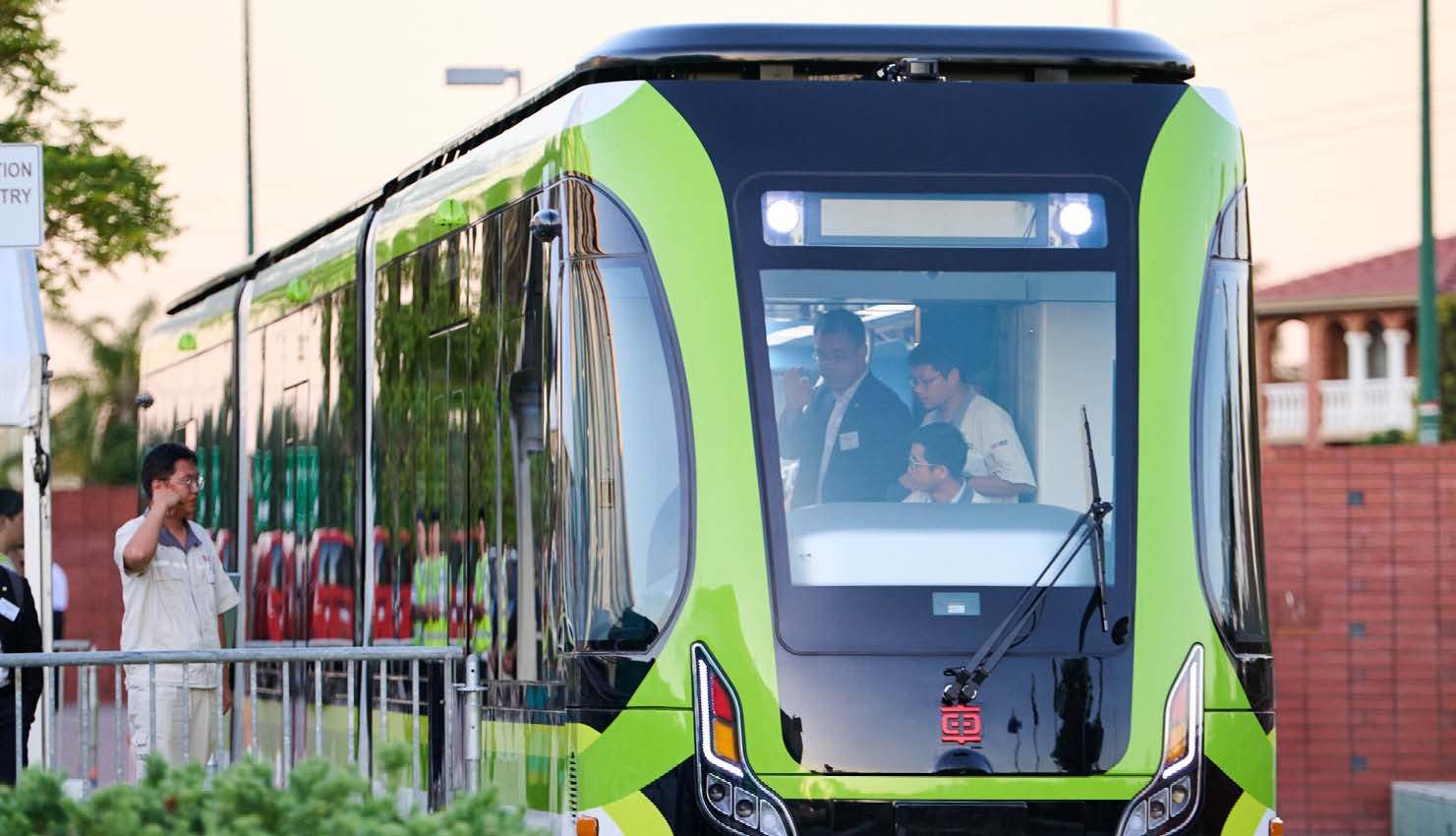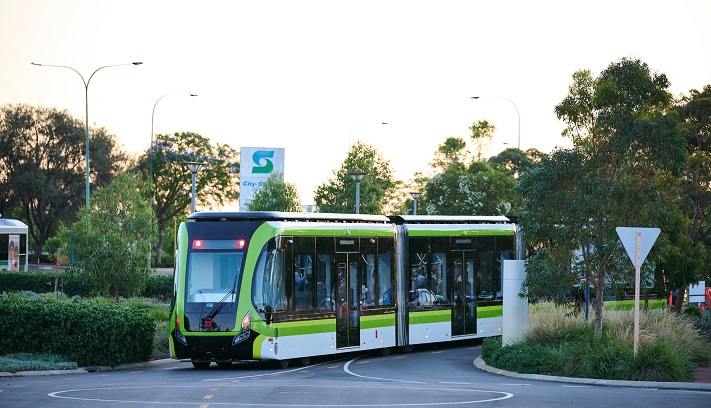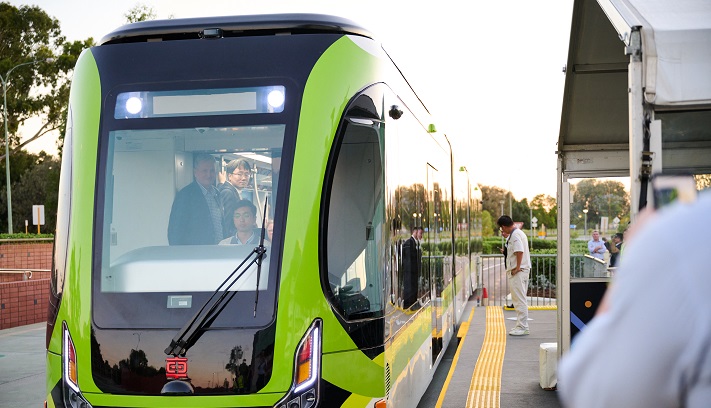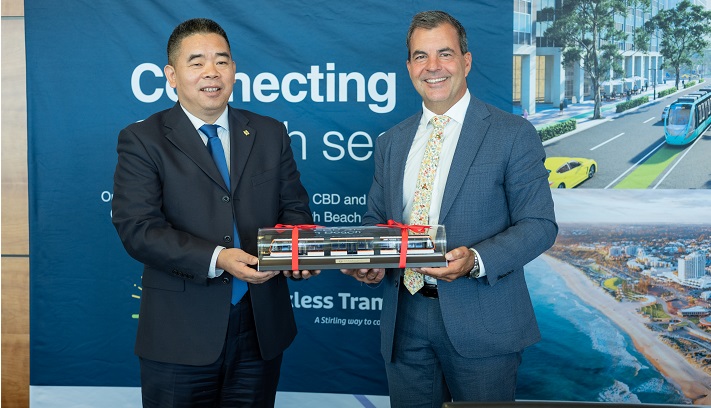
This page contains the Business Case to implement Trackless Trams along Scarborough Beach Road between Glendalough Train Station and Scarborough Beach.
Trackless Tram Business Case
In 2021, following the allocation of Australian Government funding of $2 million under the Urban Congestion Fund, the City commenced work on the Trackless Tram Business Case.
Aligning with the City’s broader vision for the Scarborough Beach Road Activity Corridor, the project aimed to create a vibrant urban centre with improved public transport, increased jobs and additional housing for the local community.
The Scarborough Beach Road Activity Corridor extends 7km from Glendalough Station to Scarborough Beach. The City of Stirling’s planning framework for the Scarborough Beach Road Activity Corridor is in place and was developed in partnership with the Department of Planning, Lands and Heritage, on behalf of the Western Australian Planning Commission. This Framework provided an overarching transport and land use vision that, when implemented over time, would significantly enhance the form and function of the road and its surroundings.
Planning for the urban regeneration area was based on a long-term vision for light rail as part of a mid-tier transit system; a system that had already proven highly successful in many cities across Australia and the world. Preliminary business cases for light rail were developed; however, new transit technology in Trackless Trams emerged as a more suitable alternative.
The Trackless Tram Business Case, finalised in October 2024, identified this innovative and sustainable public transport system as a catalyst for the nationally significant revitalisation of the Scarborough Beach Road Activity Corridor. The City of Stirling advocated to both the State and Federal Governments for the implementation of this essential project.
The Trackless Tram Business Case aimed to provide an independent assessment of various transit technologies to determine the most suitable option for the Scarborough Beach Road Activity Corridor and thereby delivering the vision for the area. The Business Case has been endorsed by Council and will be submitted to the Western Australian Government for consideration and implementation of this mid-tier transit system.
The City’s Trackless Tram Business Case includes comprehensive and independent research, conducted by several respected global transport and engineering consultants, over two separate packages of work.
Package 1: Business Case Feasibility and Scope Definition
The City appointed independent consultants ARUP to deliver Package 1. A pre-feasibility study was conducted into medium capacity transit systems along the Scarborough Beach Road Activity Corridor, considering new technologies such as Trackless Trams. The scope included assessment criteria such as:
- Modal integration
- Impact and disruption on infrastructure, community, and business
- Ease of implementation
- Compliance
- Impact on local traffic and more.
The study identified emerging commercially available vehicles, that are fundamentally a hybrid between traditional Light Rail Transit and Bus Rapid Transit vehicles. The assessment concluded that the Trackless Tram vehicles manufactured by CRRC were the most suitable vehicle for the Scarborough Beach Road Activity Corridor.
For further information on the feasibility and scope definition, refer to the ARUP Business Case Feasibility and Scope Definition report.
Package 2: Business Case Development
The City appointed SMEC to deliver Package 2; a comprehensive body of work which developed the preliminary business case, to de-risk the project and address:
- Project definition and purpose
- Land use and planning
- The preferred system
- Engineering and sustainability
- Delivery methodology, potential risk and-or problems, opportunities, and more.
For further information, refer to the Trackless Trams Business Case Development Package 2 – SMEC Report.
Strategic Need and Justification
To conduct further due diligence in regard to the Trackless Tram Business Case, the City engaged additional support from experienced land use consultants Urbis, appointed in 2024 to further explore how a Trackless Tram could catalyse the urban revitalisation of the Scarborough Beach Road Activity Corridor.
Urbis identified in its report that the redevelopment of the Scarborough Beach Road Activity Corridor through Trackless Tram investment represented a once-in-a-generation opportunity for urban transformation. Furthermore, this project would fulfill State and Federal Government urban policy objectives for sustainable and compact urban growth, improving housing supply and economic outcomes for the City of Stirling and the broader Perth metropolitan area.
For further information, refer to the Urbis Report - Compact, Connected, Competitive: The Trackless Tram Transformation.
Trackless Tram Trial
In March 2022, the City of Stirling received permission from the Federal Government to utilise $135,000 of the business case funding to conduct a Trackless Tram trial.
Central to mid-tier transport planning is the consideration of the needs of the communities that mid-tier transport modes will connect. The City adopted an innovative approach to conduct this research by conducting an Australian First Trackless Tram Trial in November 2023. Over a period of eight weeks, the City worked with partners Curtin University, CRRC, Shanghai Electric and Infrastructure Technology Solutions Group (ITSG) to prepare for a trackless tram trial with a dedicated route in the City’s Administration car park.
The purpose of the Trial was to showcase the mode of transit to improve awareness of the project, bring together industry experts to conduct a study of the vehicle and understand community interest in response to the trackless tram.
The Trackless Tram vehicle testing program that occurred prior to and during the Trial in November 2023 enabled technical experts and researchers understand:
- Charging capacity/battery performance
- Sensor reliability
- Obstacle detection
- Communications
- Manoeuvrability/turning circles
- User experience.
Comprehensive field testing of the Trial vehicle against the Australian Design Rules (ADR), Disability Standards for Accessible Public Transport (DSAPT) and Performance Based Standards (PBS) was conducted by Tiger Spider on behalf of the City’s partner, ITSG.
The Trackless Tram Community Showcase held on 26 November 2023 was a highlight of the Trial and a major success. More than 1,300 people attended the events to jump on board the Trackless Tram, experience this innovative technology first-hand and provide their feedback.
A Net Zero Transit Symposium was held on 21 and 22 November in conjunction with the trial. The conference brought together national and international industry experts to discuss the latest in mid-tier net zero transit options and provided the opportunity for attendees to view the Trackless Tram in action.
The Trial and associated events provided exclusive insights into this innovative technology and overwhelmingly positive support from the community to drive this project forward. Trial results guided the City’s Business Case and advocacy for the implementation of the Trackless Tram.
For further information please refer to Trackless Tram Trial Report.
Project timeline
October 2020
$2 million grant from Australian Government (Urban Congestion Fund)
February 2021
Council endorsed scope
March 2021
Arup engaged for Package 1
August 2021
Package 1 competed
December 2021
SMEC engaged for Package 2
May 2022
Stage 1 of Business Case (‘problems and opportunities’) completed
August 2022
Stage 2 of Business Case (identification and analysis of options’) completed
October 2024
Business Case completed
View more
For more information, or to receive this information in an alternate format, please contact the City on (08) 9205 8555 or visit www.stirling.wa.gov.au/enquiry.







